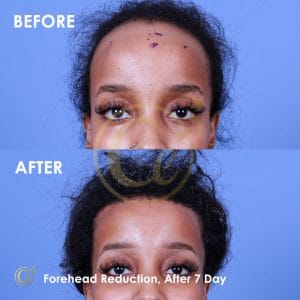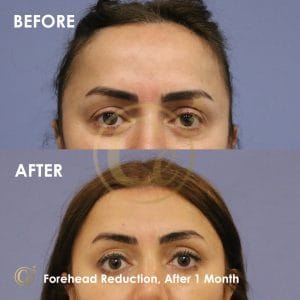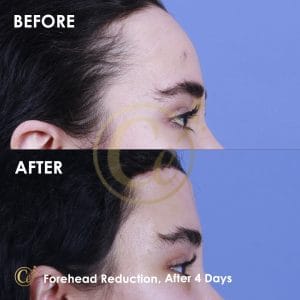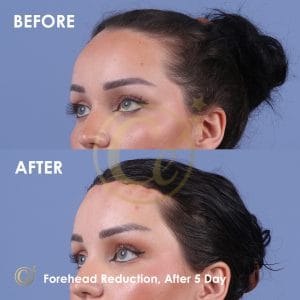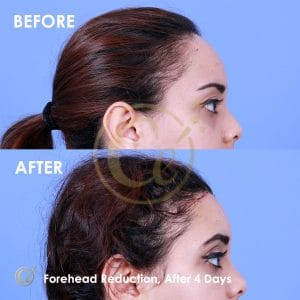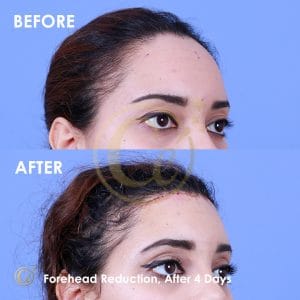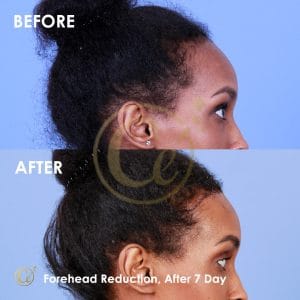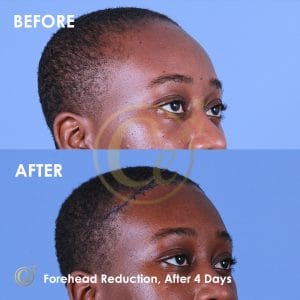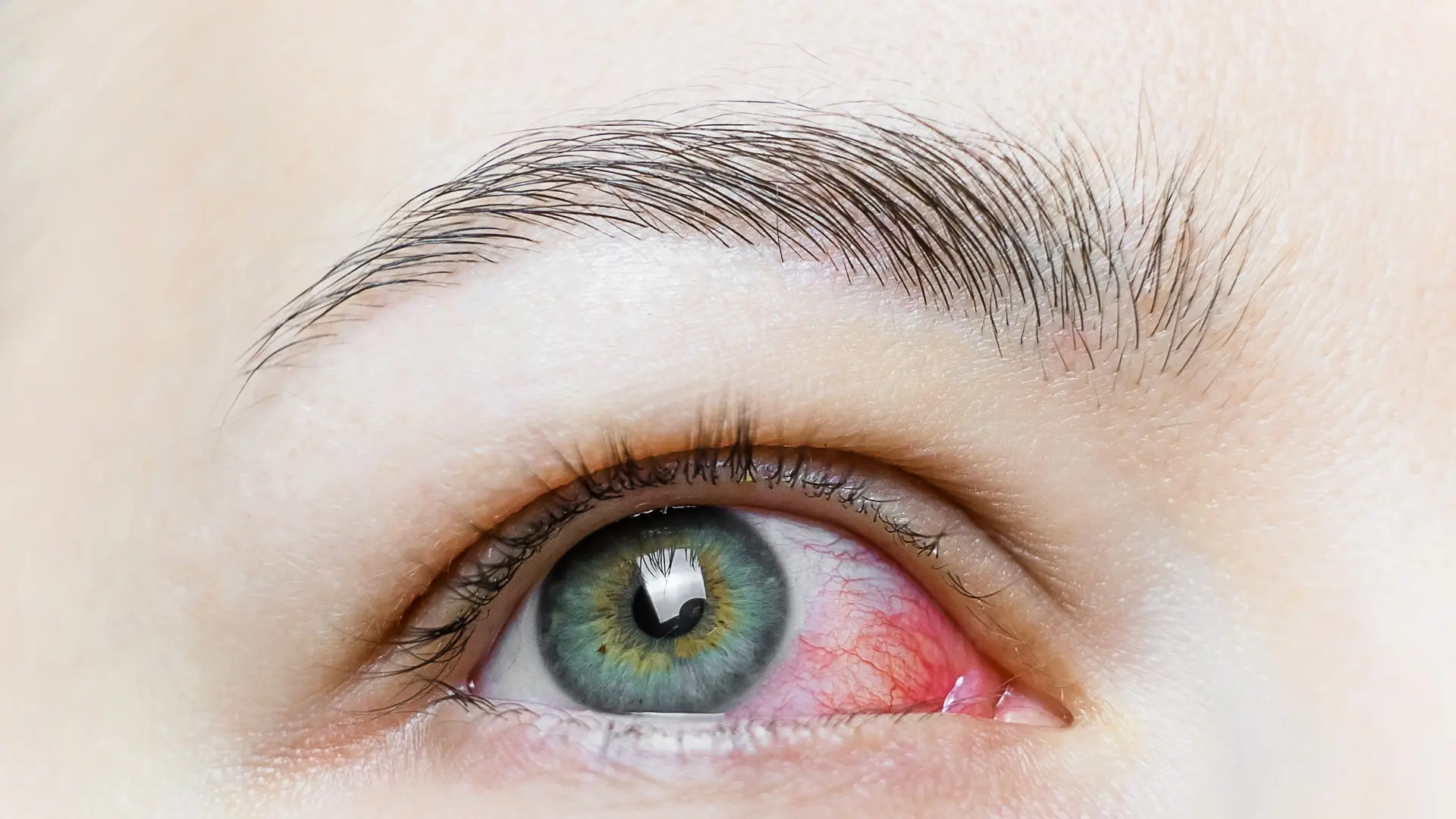Our face represents us and defines our expression; therefore, the proportion of its features is crucial.
The forehead, nose, and mouth constitute the three fundamental parts of our face, and their proportions to each other are expected to be equal. If the forehead area exceeds a 1/3 ratio, you might be a suitable candidate for forehead reduction surgery, also known as a hairline-lowering procedure.
Forehead reduction surgery involves the removal of hairless skin just below the hairline, typically up to 4 cm.
- Forehead region: Upper Horizontal ⅓ Area
- Nose region: Middle Horizontal ⅓ Area
- Mouth region: Lower Horizontal ⅓ Area
The average vertical length of a human face is approximately 17 cm. For the forehead area, the expected length is 1/3 of this, which means 5.7 cm. If the distance between the hairline and eyebrow region is longer than expected, you may be a suitable candidate for this surgery.
Individuals with a forehead longer than 5.7 cm are considered suitable candidates.
Table of Contents
Ideal Candidates
- Individuals with a wide forehead: those who have a forehead length of 5.7 cm or longer.
- Individuals with a low risk of hairline recession (hair loss), with females being particularly fortunate.
Low Suitability
- Men with severely receding hairlines, irregular hairlines, or those who may experience future hair loss are less suitable for surgery.
- Some women may experience male-pattern baldness. The most prominent feature of this type of baldness is the recession of the hairline from the temples backward. Surgery in individuals experiencing this type of baldness can be more challenging.

Surgery Process
The surgery is a surgical procedure performed under general anesthesia, typically taking about 2 hours. Before the surgery, measurements are taken to determine how much skin will be removed from the forehead. The golden ratio (an important measure in all aesthetic surgeries) is calculated for accurate markings.
Up to 4 cm of skin can be removed from the area just below the hairline. The incision is made in a zigzag pattern (pretrichial line) from where the hair-bearing skin ends. Hair follicles are preserved during the surgery to minimize the visibility of scars. After the marked skin section is removed, The skin is closed with aesthetic stitches.
Forehead Reduction with Fox Eye Surgery
The surgery can be combined with eyebrow lifting, fox eye, and mid-face lift procedures.
If eyebrow lifting is performed alongside forehead reduction surgery, the incision area on the forehead can be slightly widened toward the sides. If no change in facial expression is desired, the forehead skin can be fixed during the stitching process. The hair-bearing skin is pulled forward during stitching.
Big Forehead Surgery
The average length of the human forehead is about 5.7 cm. For example, a person with a forehead of 9–10 cm is considered to have a big forehead. Lowering the hairline by 2–3 cm may not be enough in those circumstances. In this case, there are two options:
- Forehead reduction in two operations.
- Forehead reduction in two operations using the balloon technique.
Big Forehead Reduction in Two Operations
In the first operation, a 2.5-3 cm area is removed. One year later, a second operation is performed, and an additional 1.5 or 2 cm can be reduced. This way, a forehead reduction of approximately 5-7 cm can be achieved.
Big Forehead Surgery Using the Balloon Technique (2 Steps)
In the forehead reduction with the balloon technique, the patient undergoes two surgeries. In the first surgery, a balloon is placed under the hair-bearing skin, and the incision is closed without any reduction.


Approximately 2 weeks after, when the stitches are secure, fluid injection begins under the supervision of a doctor on a weekly basis. This process, depending on the elasticity of the skin, takes 8–10 weeks.
After gaining elasticity and expanding in volume, the hair-bearing skin is removed in a second operation, completing the process.

With the balloon technique, reduction can be up to 7 cm.
Recovery Process After Forehead Reduction Surgery
The recovery process for forehead reduction surgery is faster and more comfortable compared to other surgeries. Staying in the hospital for one day after the surgery is sufficient.
For the first 2 days after the surgery, a bandage and ice application are performed. A shower can be taken from the second day onward, as long as the water is not too hot. Swelling will significantly decrease over the next week. After one month, the scar will become less noticeable. Complete resolution of all swelling and seeing the final result will take about 6 months.
Sun protection is important for everyone, including after forehead reduction surgery. Keeping the hair not completely combed backward, i.e., not exposing the forehead, also aids in protecting the surgical area.
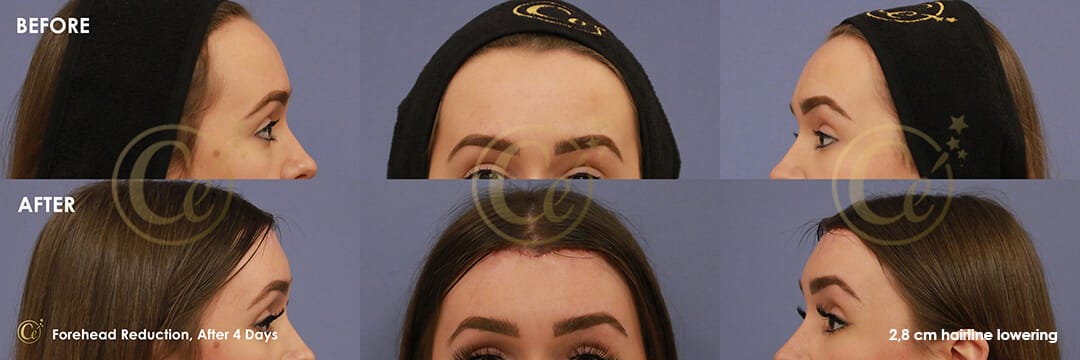
Applications Speeding Up Healing and Reducing Scars
Dr. Cengizhan Ekizceli can apply three types of recovery processes and scar-reducing treatments to patients who have undergone forehead reduction surgery, either individually or in combination.
- PRP (Platelet Rich Plasma) Treatment: In this treatment, a sample is taken from the patient’s blood, enriched with effective enzymes for wound healing through centrifugation, and then injected into the surgical area. This treatment can be applied the day after surgery and repeated monthly.
- Stem Cell-Based Fat Injection:
During this method, a portion of fat tissue rich in stem cells is taken during the surgery, stem cells are separated, and then applied to the operation area. Stem cells are cells in our body capable of transforming into various types of cells. In this application, we benefit from the effects of stem cells in accelerating wound healing.
- Hair Transplantation: If patients become bothered by the faint scar after surgery or experience a decrease in hair volume around the scar or on the sides of the forehead, hair transplantation can be applied to these areas.
Forehead Reduction—Hairline Lowering in Turkey: Before and After (Frontal View)
Forehead Reduction—Hairline Lowering in Turkey: Before and After (Side View)
Videos After Forehead Reduction Turkey
Dr. Cengizhan Ekizceli’s Experience in Forehead Reduction Surgery
Dr. Cengizhan Ekizceli can be considered one of the most experienced doctors in forehead reduction in Turkey.
Between 2019 and 2024, he performed this operation on more than 600 individuals.
Forehead reduction surgery, or hairline lowering, can be completed in a short time—around 1–2 hours. Compared to other plastic surgery procedures, forehead reduction surgery has fewer complications and risks. Dr. Cengizhan Ekizceli has gained significant experience in the incision method, stitching, and accelerating the healing process for forehead reduction surgery.
The C Reduction name comes from Dr. Cengizhan’s name. It is an individual technique for forehead reduction surgery, featuring:
Unique incision pattern (zig-zag incision)
Cutting the skin at a 45-degree angle to preserve hair follicles and effectively hide scars
Skin stitching using at least five different threads
To contact Dr. Cengizhan Ekizceli regarding forehead reduction surgery or other aesthetic treatments, you can reach out through our contact page.


